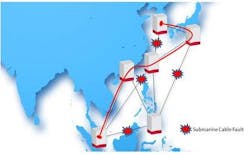Providing mesh protection for submarine networks
Terrestrial optical networks are stitched together via submarine cables that interconnect all continents, except Antarctica, into a seamless global network infrastructure. These marvels of engineering are laid upon deep ocean floors and routed around physical undersea obstacles until being buried several kilometers from landfall for increased protection against ship anchors and fishing trawlers.
These fragile submarine cables are absolutely critical to global communications, yet are for the most part unknown or underappreciated by most people. That is, until a wide-scale network outage occurs, bringing their importance to the forefront of international scrutiny.
Several recent examples have demonstrated that legacy ring-based protection has proven both inadequate and inefficient when dealing with multiple simultaneous cable faults. A more resilient solution is required – mesh protection with an intelligent control plane.
Hostile undersea operating environment
In recent years, several high-profile incidents have resulted in wide-scale submarine network degradations and even outright outages.
In 2006, a major undersea earthquake struck off the southern coast of Taiwan and disrupted telecommunications for hundreds of millions of people. Approximately 10 submarine cables were damaged in more than 20 locations by undersea landslides, resulting in cable repairs that took weeks to complete. This major incident had an immediate and far-reaching effect, as all major voice and data routes to Asia were impaired. In particular, telecommunication services to Taiwan and Hong Kong degraded severely.
Three years later, in 2009, typhoon Morakot struck Taiwan. It caused major damage to 10 undersea cables and once again resulted in wide-scale network outages.
Both of these natural disasters created major disruptions because numerous submarine cables traverse the same Luzon Strait to the south of Taiwan, where undersea landslides occurred. Ring-based network protection was actually implemented over some of the submarine cables. However, given the magnitude of the undersea landslides, both working and protection cables were severed, resulting in significant network disruptions.
In 2008, multiple manmade submarine cable cuts in the Mediterranean Sea and Persian Gulf, believed to be caused by ship anchors, affected close to 100 million people as regional networks slowed to a crawl, when they weren’t temporarily knocked out altogether. Although the cause of this incident was related to human error, the regional impact was still widespread and further emphasized the need for improved network resilience, as global network connectivity has become a matter of national security.
Last year, a major earthquake struck off the east coast of Japan, followed by a tsunami, that caused extensive human suffering and major infrastructure damage. The toll included an estimated 12 faults to approximately five different undersea cables. The tsunami also severely damaged cable landing stations, which simply added stress to the already battered telecommunication infrastructure. Although some network operators had implemented intelligent mesh networks in the region, which autonomously rerouted traffic around faults even as numerous aftershocks caused ongoing submarine cable faults over hours/days, several carriers did not.
And earlier this year, four major submarine cables linking East Africa to the Middle East and Europe were severed, resulting in significant network degradation to nine African countries. It took weeks for maintenance crews to repair these damaged submarine cables. A few months later, a major submarine cable was severed approximately 60 km off the coast of Singapore. The incident crippled network connectivity to Bangladesh, which at the time did not have a backup path to reroute traffic.
These are just a few examples where submarine cable faults have resulted in significant regional network degradation or outright outages. Such problems are intolerable in today’s highly interconnected world. According to the International Cable Protection Committee, submarine fiber-optic cables carry close to 100 percent of all international Internet traffic and more than 95 percent of all combined international voice and data traffic, which further underscores the critical importance of the global submarine network.
In fact, there isn’t an alternative network technology available today, including satellite technology, that can cost-effectively scale to deliver the massive amount of information currently being sent over the global undersea cable network. However, recurring outages such as those described above have shown that we need to make improvements to ensure global network availability.
Network intelligence and the control plane
The “brain” of an intelligent network is its control plane, which comprises dedicated hardware and software that together enable a “self-aware” network. The control plane autonomously maintains an accurate database of all network resources, in near real-time, to facilitate optimal connection-management decisions.
Legacy networks employ centralized intelligence, which is typically network management software running on an external workstation for connection management. A network employing an intelligent control plane has a “nervous system” whereby connection management is autonomously performed by the network itself, albeit within predefined boundary conditions. This fundamental shift in connection management from an external centralized model to an internal decentralized model brings network operators significant business benefits, such as rapid service creation and significant savings in capital and operational expenditures.
It should be noted that an intelligent network with control plane technology will only make connection management, protection, and restoration decisions based on the policies created by human operators. Although connections are autonomously created and deleted via machine-to-machine signaling and routing protocols, the human operator is always in total control of the intelligent optical network.
The network is the database
A self-aware intelligent network regularly polls all interconnected nodes to gather the relevant information required to make autonomous connection management, protection, and restoration decisions. This enables the control plane to maintain an accurate and timely topological view of the network and its underlying resources, which together form the basis for future connection management decisions. Any change to the network, such as wavelength upgrades from 10 Gbps to 100 Gbps, is auto-discovered and the network database is immediately updated.
Each intelligent node in the mesh network is fully aware of all network connections, as well as associated performance expectations. In a disaster scenario, such as an undersea earthquake triggering multiple simultaneous submarine cable cuts, connections will be autonomously and rapidly rerouted around faults while still maintaining guaranteed service-level agreements (SLAs). A major benefit of each node maintaining a timely and accurate network-wide database is that multiple redundant nodes are created to enable a highly resilient network, since there is no single point of database failure.
Legacy ring-based networks vs. intelligent mesh networks
A primary benefit of an intelligent mesh-based optical network is its ability to rapidly and autonomously reroute connections around inevitable submarine cable faults. Properly designed mesh networks can achieve 99.9999 percent availability, which translates into only 31 seconds of annual downtime and is a tenfold improvement over legacy ring-based networks. This brings a considerable increase in network availability and is a stark contrast to traditional ring-based network designs that have proven to bring costly restoration challenges in the event of multiple simultaneous network faults.
Mesh networks are highly interconnected topologies that comprise multiple diverse paths, yielding more options to reroute traffic around network faults. Multiple diverse paths can also reduce overall network capacity by more than 30 percent when compared to ring-based networks, yet provide the same or better availability because protection and restoration bandwidth is shared among multiple connections.
Legacy ring-based protection requires that half the overall network capacity be reserved (some say wasted) for protection purposes, when and if required. When a multi-fault scenario occurs, such as the wide-scale disasters discussed earlier involving multiple submarine cables being severed in multiple locations, ring-based protection is simply inadequate, resulting in traffic outages. Although traffic can be placed on the protection paths of the ring under non-fault conditions, this extra traffic is preempted (lost) once a protection switch has occurred. Ring-based topologies also require that the line rate around the ring be the same regardless of the traffic patterns between nodes on the ring. This leads to some ring segments being better used than others, which results in stranded capacity that doesn’t generate any revenue.
Intelligent mesh networks rapidly and autonomously restore connections around multiple failures using its accurate database of available network resources as its reference. As long as a viable path is present, traffic restoration is possible -- so the more diverse paths designed into a mesh network, the better the overall network availability. This was precisely the case during the devastating earthquake last year off the coast of Taiwan, where service providers with highly meshed networks rerouted traffic around multiple failures across multiple submarine cable, with no network outages – an impressive feat given the extent of the disaster.
Mesh-based networks are also line-rate independent, meaning they can scale to 100 Gbps and beyond. It also means that network segments between meshed nodes can be optimized based on expected traffic patterns, which enables network planners to deploy 10 Gbps, 40 Gbps, or 100 Gbps whenever and wherever required. This leads to significant improvements in overall network capacity use. In today’s hyper-competitive telecom market, network optimization is a primary design goal because it enables network operators to maximize the return on their substantial network infrastructure investments.
Automated connection management
An intelligent mesh network greatly facilitates connection management by enabling the network itself to decide how to route and reroute connections while respecting guaranteed SLAs. Since an intelligent network uses autonomous node-to-node signaling and routing protocols, connection management is extremely fast and highly reliable. Lengthy and error-prone manual operations that are prevalent in legacy networks are essentially eliminated, resulting in significant operational cost savings and far faster service creation.
These benefits are further accentuated as terrestrial and submarine networks are seamlessly stitched together into a single global network entity, making it just as easy to create a network connection from New York to Boston as one from New York to Singapore. Automated connection management governed by the intelligent control plane and its network nervous system also enables performance-on-demand services and software-defined networks.
Sea of change
The ability to maintain global network availability, regardless of inevitable undersea cable faults, will only increase in importance as mankind becomes increasingly dependent on this precious manmade resource. Network operators are diligently addressing voracious intercontinental bandwidth demand by upgrading their wet plants from 10 Gbps to 40 Gbps and 100 Gbps, taking submarine cable total traffic-carrying capacities into multi-terabit ranges. This will make future cable outages even more devastating to network operators and their customers.
An intelligent mesh network design ensures availability even when multiple simultaneous submarine cable faults occur. This is precisely why several global service providers have already deployed this resilient network technology in high-risk regions of the world. Higher-speed submarine cables meshed together and managed by an intelligent control plane is the best way to build tomorrow’s global communications network, today.
Brian Lavallée is the director responsible for global networks solutions at Ciena and can be reached at [email protected].


